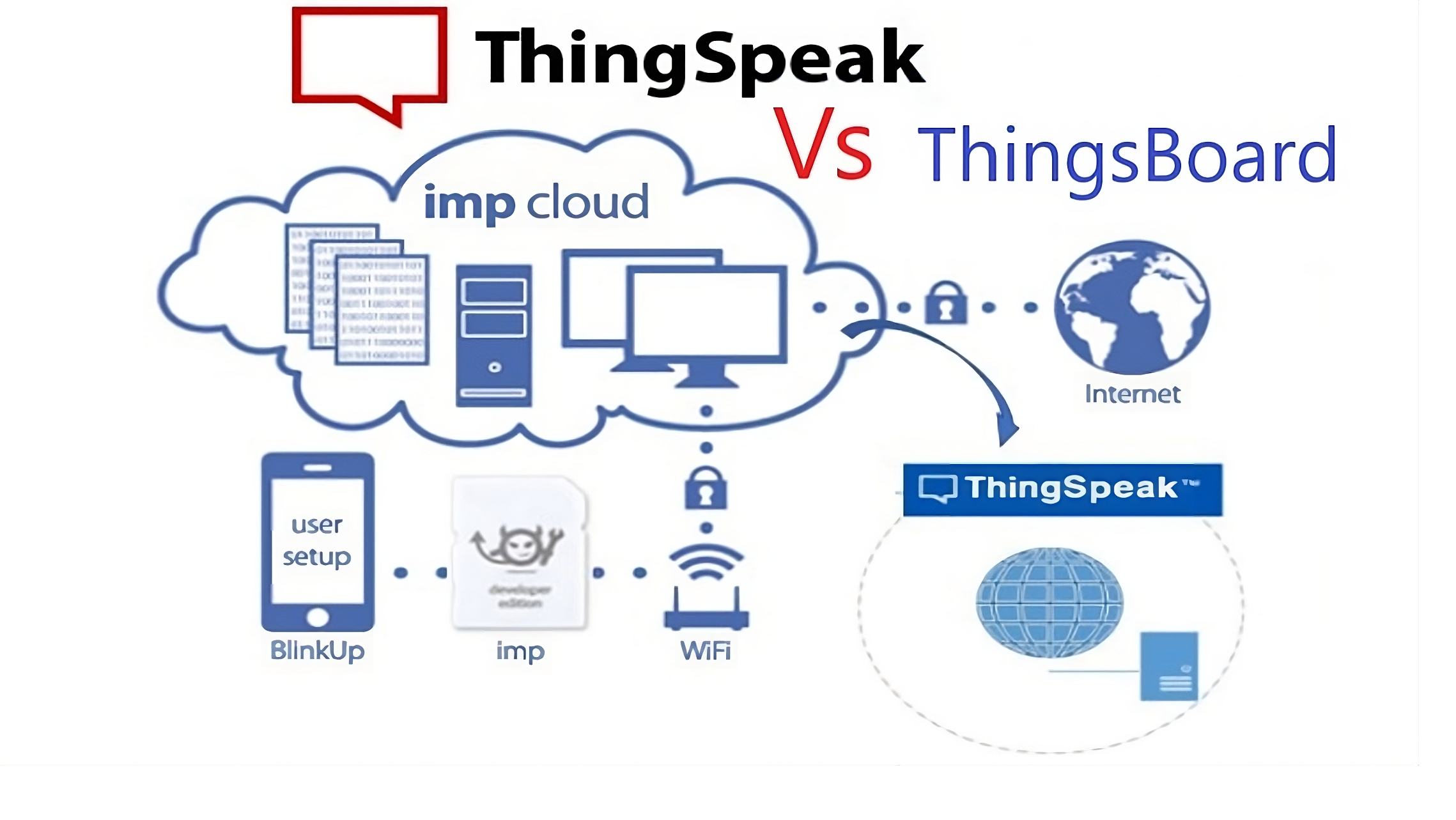In this Article
- Introduction
- Overview of IoT Platforms
- What is ThingsBoard?
- Key Features of ThingsBoard
- What is ThingSpeak?
- Comparative Analysis: ThingsBoard vs ThingSpeak
- Device Management in ThingsBoard vs ThingSpeak
- Data Visualization in ThingsBoard vs ThingSpeak
- Rule Engine and Data Processing in ThingsBoard vs ThingSpeak
- Security in ThingsBoard vs ThingSpeak
- Integration and Extensibility in ThingsBoard vs ThingSpeak
- Future Trends in IoT Platforms
- Edge Computing in IoT Platforms
- Artificial Intelligence and Machine Learning in IoT Platforms
- Conclusion
- How We Can Help
- Reference
Introduction
The Internet of Things (IoT) has ushered in a new era of connectivity, allowing devices to communicate and share data seamlessly. At the heart of this revolution are IoT platforms that provide the necessary tools and infrastructure for managing IoT devices and data. Two popular open-source IoT platforms are ThingsBoard and ThingSpeak. This article provides a detailed comparison of ThingsBoard vs ThingSpeak, highlighting their key features, benefits, and differences to help you choose the right platform for your IoT projects.
Overview of IoT Platforms
What is ThingsBoard?
ThingsBoard is an open-source IoT platform that enables the collection, processing, and visualization of data from connected devices. It offers a robust set of features for device management, data analytics, and visualization, making it suitable for a wide range of IoT applications.
Key Features of ThingsBoard
- Device Management: Provides tools for provisioning, monitoring, and managing IoT devices.
- Data Visualization: Offers customizable dashboards and widgets for real-time data visualization.
- Rule Engine: Allows the creation of complex data processing rules for automation and decision-making.
- Security: Ensures secure communication and data protection with robust authentication and encryption mechanisms.
What is ThingSpeak?
ThingSpeak is an open-source IoT analytics platform service that allows users to aggregate, visualize, and analyze live data streams in the cloud. It is designed for quick prototyping and deployment of IoT applications, providing easy integration with MATLAB for advanced data analysis.
Key Features of ThingSpeak
- Data Ingestion: Supports data collection from various sensors and devices through HTTP and MQTT.
- Visualization: Provides tools for creating real-time data visualizations and custom dashboards.
- Data Analysis: Integrates with MATLAB for advanced data analysis and algorithm development.
- Public and Private Channels: Allows the creation of public and private channels for data sharing and collaboration.
Comparative Analysis: ThingsBoard vs ThingSpeak
Device Management in ThingsBoard vs ThingSpeak
ThingsBoard
ThingsBoard excels in device management with its comprehensive set of tools for device provisioning, monitoring, and management. It supports multiple device types and communication protocols, enabling seamless integration with various IoT devices.
- Provisioning and Authentication: Secure device registration and authentication.
- Remote Management: Allows remote configuration and control of devices.
- Monitoring and Diagnostics: Provides real-time monitoring and diagnostics to ensure device health and performance.
ThingSpeak
ThingSpeak offers basic device management capabilities, primarily focusing on data ingestion and visualization. It is suitable for smaller-scale projects and quick prototyping but lacks the advanced device management features of ThingsBoard.
- Device Registration: Simple device registration through API keys.
- Data Ingestion: Supports data collection from sensors and devices via HTTP and MQTT.
- Basic Monitoring: Provides basic monitoring capabilities through data channels.
Data Visualization in ThingsBoard vs ThingSpeak
ThingsBoard
ThingsBoard offers powerful data visualization tools, allowing users to create customizable dashboards and widgets. Its intuitive interface makes it easy to design and deploy real-time data visualizations.
- Custom Dashboards: Create custom dashboards with drag-and-drop widgets.
- Real-Time Visualization: Visualize real-time data from connected devices.
- Historical Data: Access and visualize historical data for analysis and reporting.
ThingSpeak
ThingSpeak provides straightforward data visualization capabilities, making it ideal for quick and easy data monitoring. It supports various visualization options, including line charts, bar charts, and gauges.
- Custom Dashboards: Create custom dashboards with multiple visualization options.
- Real-Time Data: Visualize real-time data streams from IoT devices.
- MATLAB Integration: Enhance visualizations with MATLAB plots and analysis.
Rule Engine and Data Processing in ThingsBoard vs ThingSpeak
ThingsBoard

Image by rawpixel.com on Freepik
ThingsBoard features a robust rule engine that enables complex data processing and automation. Users can define rules to process incoming data, trigger actions, and generate alerts based on specific conditions.
- Complex Rule Creation: Define complex rules for data processing and automation.
- Alerts and Notifications: Generate alerts and notifications based on predefined rules.
- Integration: Integrate with external systems and services through REST APIs and MQTT.
ThingSpeak
ThingSpeak offers basic data processing capabilities, primarily focusing on data aggregation and visualization. It supports simple triggers and actions but lacks the advanced rule engine features of ThingsBoard.
- Basic Triggers: Define basic triggers to process incoming data.
- Data Aggregation: Aggregate data from multiple channels for analysis.
- MATLAB Integration: Perform advanced data processing and analysis using MATLAB.
Security in ThingsBoard vs ThingSpeak
ThingsBoard
ThingsBoard places a strong emphasis on security, offering robust authentication, authorization, and encryption mechanisms. It ensures secure communication between devices and the platform, protecting data integrity and privacy.
- Authentication and Authorization: Secure device and user authentication and authorization.
- Data Encryption: Encrypts data during transmission and storage.
- Role-Based Access Control: Implements role-based access control for granular permissions.
ThingSpeak
ThingSpeak provides basic security features, suitable for smaller-scale projects and rapid prototyping. It supports API key-based authentication and allows users to create public and private channels for data sharing.
- API Key Authentication: Secures device communication with API keys.
- Public and Private Channels: Control data visibility with public and private channels.
- Basic Encryption: Supports basic data encryption during transmission.
Integration and Extensibility in ThingsBoard vs ThingSpeak
ThingsBoard
ThingsBoard offers extensive integration capabilities, supporting various protocols and APIs. It can be integrated with external systems and services, enhancing its functionality and scalability.
- Protocol Support: Supports MQTT, CoAP, HTTP, and other communication protocols.
- REST API: Provides REST APIs for integration with external applications.
- Custom Extensions: Allows the development of custom extensions and plugins.
ThingSpeak
ThingSpeak provides straightforward integration options, focusing on ease of use and rapid deployment. It supports integration with MATLAB for advanced analytics and can be extended with custom plugins.
- MATLAB Integration: Seamlessly integrates with MATLAB for advanced analysis.
- API Support: Supports HTTP and MQTT for data ingestion and integration.
- Custom Plugins: Extend functionality with custom plugins and scripts.
Use Cases
ThingsBoard Use Cases
- Smart Agriculture: ThingsBoard is used to monitor soil moisture, weather conditions, and crop health, optimizing irrigation and improving crop yields.
- Benefits: Enhanced crop management, reduced water usage, and increased yields.
- Example: Deploying soil sensors and weather stations to provide real-time data to farmers.
- Impact: Improved decision-making and resource allocation in agriculture.
- Industrial Automation: Provides real-time monitoring and control of industrial equipment, enhancing efficiency and reducing downtime.
- Benefits: Improved operational efficiency, reduced downtime, and predictive maintenance.
- Example: Monitoring machinery performance and automating maintenance schedules.
- Impact: Increased productivity and reduced maintenance costs.
- Smart City Solutions: Powers smart lighting, waste management, and environmental monitoring systems, improving urban services and sustainability.
- Benefits: Enhanced urban services, reduced energy consumption, and improved environmental quality.
- Example: Implementing smart streetlights that adjust brightness based on real-time data.
- Impact: Improved energy efficiency and urban infrastructure management.
ThingSpeak Use Cases
- Environmental Monitoring: ThingSpeak is used to monitor air quality, water quality, and weather conditions, providing valuable data for environmental research and management.
- Benefits: Real-time environmental data collection, improved research capabilities, and public awareness.
- Example: Deploying air quality sensors to monitor pollution levels in urban areas.
- Impact: Enhanced environmental monitoring and data-driven policy-making.
- Home Automation: Powers simple home automation projects, such as monitoring energy usage and controlling home appliances.
- Benefits: Increased energy efficiency, improved home security, and convenience.
- Example: Automating home lighting and heating systems based on occupancy data.
- Impact: Reduced energy bills and enhanced comfort for homeowners.
- Educational Projects: Ideal for educational purposes, allowing students to quickly prototype and deploy IoT projects.
- Benefits: Hands-on learning experience, easy-to-use platform, and integration with MATLAB for advanced analysis.
- Example: Students creating a weather station to collect and analyze local weather data.
- Impact: Improved understanding of IoT concepts and practical application.
Future Trends in IoT Platforms
Edge Computing in IoT Platforms

Image by jcomp on Freepik
Edge computing is becoming increasingly important in IoT deployments. By processing data locally at the edge of the network, edge computing reduces latency and improves real-time decision-making.
- Latency Reduction: Reduces latency by processing data closer to the source.
- Real-Time Processing: Enhances real-time data processing and analytics capabilities.
- Scalability: Supports the scalability of IoT deployments by distributing data processing across the network.
Artificial Intelligence and Machine Learning in IoT Platforms
AI and machine learning are playing a significant role in enhancing the capabilities of IoT platforms. These technologies enable advanced data analytics, predictive maintenance, and automated decision-making.
- Predictive Maintenance: Uses machine learning algorithms to predict equipment failures and schedule maintenance.
- Automated Decision-Making: Enhances decision-making processes through AI-driven insights.
- Data Analytics: Provides advanced data analytics capabilities for deeper insights into IoT data.
Conclusion
Both ThingsBoard and ThingSpeak offer valuable features for IoT deployments, but they cater to different needs and project scales. ThingsBoard is a more robust and feature-rich platform, suitable for large-scale industrial applications and projects requiring advanced device management, data processing, and security. On the other hand, ThingSpeak is ideal for smaller-scale projects, quick prototyping, and educational purposes, offering ease of use and integration with MATLAB for advanced analytics.
Choosing the right platform depends on your specific requirements, project scale, and desired features. By understanding the strengths and capabilities of each platform, you can make an informed decision that best meets your IoT project needs.
How We Can Help
At Minnovation, we specialize in developing and managing comprehensive IoT solutions tailored to meet the unique needs of your business. Our team ensures seamless integration of IoT platforms with your existing systems, prioritizing compatibility and scalability. Additionally, we offer expert consultation services to guide you through each step of the process, ensuring your IoT platform is robust, scalable, and secure. For more details, visit our site or Contact us.
Reference
Related Blog Posts
How Smart Cities Connect: Getting Started with Edge AI and IoT Technology
By Vamsi Krishna|June 24th, 2024|Categories: Articles, Smart Cities|Tags: edge AI, IoT technologies, smart cities connect, smart infrastructure, urban integration|
How to Get Started with Edge AI and IoT Technologies in Smart Cities: Overcoming Integration Challenges In recent years, the concept of smart cities has evolved from a futuristic Read More
5 Step Strategy: Ensuring Security and Privacy in 15-Minute Smart Cities
By Sanjeevan|June 23rd, 2024|Categories: Articles, Smart Cities|Tags: 15-minute smart cities, edge AI privacy, IoT Security, smart city security, urban tech|
Introduction Ensuring security and privacy in 15-minute smart cities is a critical challenge as urban areas become increasingly connected through IoT and edge AI technologies. These cities aim to Read More
What is a smart city and the challenge of legacy systems
By Sanjeevan|June 22nd, 2024|Categories: Articles, Smart Cities|Tags: legacy systems in smart cities, smart city infrastructure, smart city integration, smart city technology, what is a smart city|
How to Get Started with Integrating Legacy Systems in Smart Cities Smart cities are transforming urban landscapes by leveraging technology to improve the quality of life for residents. However, Read More




